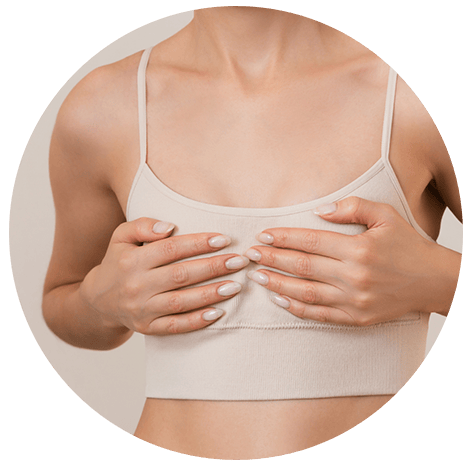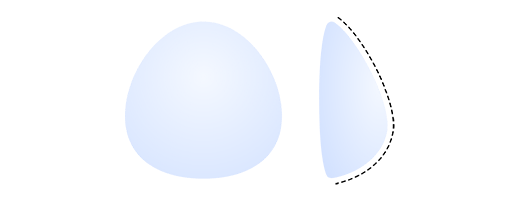Quick Facts About Breast Augmentation Procedures
- Sedation: General anesthesia
- Common Benefits: Fuller, more symmetrical, and more proportionate breasts
- Potential Side Effects: Bruising, swelling, discomfort; more rarely, infection, adverse reactions to anesthesia, implant ruptures or leaks
- Procedure Length: Approximately one hour
- Recovery Time: Strenuous activities can usually be resumed after four weeks

What Is Breast Augmentation?
Breast augmentation is an aesthetic procedure designed to enhance the size, shape, and overall appearance of the breasts through the placement of implants. Continually one of the top cosmetic surgeries performed each year, this treatment can enlarge the breasts for a more pronounced bustline; create a more proportionate, balanced figure; improve breast symmetry; restore lost breast volume following pregnancy, breastfeeding, or significant weight loss; enhance the look and fit of various articles of clothing; and/or boost self-confidence and esteem.
As an established and leading plastic surgeon in Kelowna, Dr. Brian J. Miller has a long history of achieving beautiful, natural-looking breast augmentation results. Based on your unique needs and aesthetic preferences, he can custom-tailor a treatment plan that yields the breast size and shape you desire while maximizing both comfort and safety.
To learn more about breast augmentation and what to expect, please read the sections provided below and/or contact us today to schedule a private consultation. Dr. Miller is happy to help!
What Are the Benefits of Breast Augmentation?
Breast augmentation can not only improve a woman’s appearance, but also boost her self-confidence and body image by:
- Enhancing breast volume and curves
- Correcting breast asymmetry
- Increasing comfort and ability to wear different types of clothing
- Restoring breast volume after the effects of pregnancy, weight loss, and/or aging
- Rebuilding breasts after a mastectomy
Please note that while breast augmentation can dramatically enhance the appearance of the bustline, it cannot combat ptosis (or sagging breasts) when performed on its own. For patients interested in achieving a more “lifted” effect along with added symmetry and volume, Dr. Miller is often able to combine breast augmentation with breast lift surgery.
Who Is a Good Candidate for Breast Augmentation?
Candidates for breast augmentation wish to change the size, shape, or symmetry of their breasts, which can ultimately have a positive effect on overall body proportions. Patients pursuing breast augmentation should be in good overall health and have realistic expectations for the outcome of this procedure.
Dr. Miller understands that the decision to undergo breast augmentation can be very personal and even difficult. He will gladly meet with you to evaluate your health, anatomy, and cosmetic preferences to help you determine whether this surgery is right for your needs and goals.

What Are My Breast Implant Options?
A wide range of implants are available to patients and surgeons in North America. These implants differ from one another in terms of fill (saline vs. silicone), shape (round vs. shaped), and texture of the outer shell (smooth vs. rough/textured). There are a number of advantages and disadvantages to each. These factors vary in importance depending on the individual patient.
In our practice, we most commonly use smooth, round, silicone gel-filled implants. Most patients prefer the more natural feel of silicone compared to saline. In addition, saline implants are more likely to ripple in a way that can be seen or felt. Many patients favor round implants because shaped implants must remain properly oriented (i.e. if they rotate, the shape of the breast can be affected) while round implants do not have this issue. Overall, the final decision regarding implant type depends on individual case specifics and patient preferences.

Breast Implant Types
Saline. Saline breast implants are filled with a sterile saltwater solution and encased in a silicone outer shell. One of the advantages of choosing saline implants is that in the very rare chance that the implant leaks or ruptures, the body can harmlessly absorb the saline solution and naturally expel it out of the body. This usually leads to a loss of volume or “deflation” over a relatively short period.
Traditional Silicone Gel and Highly Cohesive Silicone Gel. Many patients choose silicone implants, traditional or highly cohesive, because they are considered to look and feel more natural. Gel implants contain silicone of varying degrees of “cohesiveness.” This refers to how well the silicone sticks to itself. Highly cohesive implants tend to be more stable and firmer, while less cohesive implants are softer and more malleable.
Even though most patients do not experience implant failure, it is important to know that silicone implants usually do not collapse if there is leakage, which makes it harder to detect a rupture. As for all patients, routine breast self-exams and regular physical examinations with your physician are important. While frequent imaging specifically to monitor the implant is not mandatory, patients are encouraged to bring any new symptoms or findings to their family doctor or plastic surgeon’s attention so that these concerns can be investigated further if necessary.
Breast Implant Shapes

Teardrop-Shaped. This shape imitates the natural contours of the breast, which has less volume up top and more at the bottom. Teardrop-shaped implants can be a good choice for women who want a more discreet breast enhancement.

Round. For round implants, volume is evenly distributed throughout the implant. This shape helps give the appearance of more fullness towards the top of the breast, which can help the breasts look more perky.
Breast implants come in a variety of types, shapes, surface textures, and sizes. In many cases, Dr. Miller prefers to utilize smooth, round, silicone gel implants—though he is not opposed to placing other implant styles when appropriate. During your in-person consultation, he will cover the advantages and disadvantages of all options in great detail, helping you choose the best breast implants for your specific goals and anatomy.
How Is the Breast Augmentation Procedure Performed?
Breast augmentation can be performed using several different incision and implant placement techniques. Dr. Miller most commonly utilizes an inframammary incision and submuscular implant positioning, though alternate incisions and implant position are used in select cases. To begin the procedure, he will generally make small incisions in the inframammary fold where the bottom of the breasts meet the chest wall. Through these incisions, he will insert your selected breast implants, typically placing them in the submuscular position beneath the pectoralis major muscles. Once your implants are ideally situated, Dr. Miller will close the incisions with meticulous care to promote optimal healing and scar visibility. On average, the entire breast augmentation procedure takes approximately one hour to complete, and it is performed under general anesthesia.

What Is Recovery from Breast Augmentation Like?
Following breast augmentation, you will likely be able to resume normal, non-strenuous daily routines—such as school, office work, errands, etc.—within a few days. Some bruising and swelling can be expected initially, but these symptoms should resolve on their own with time. While significant pain is rare, any potential discomfort can be controlled with medication. In order to facilitate healing and help ensure an optimal outcome, you will need to avoid heavy lifting, vigorous exercise, contact sports, and various other physical activities for at least four weeks. After six weeks, however, all restrictions are generally lifted.
What Are the Typical Results of Breast Augmentation?
Following a breast augmentation performed by an experienced and skilled plastic surgeon, patients are typically elated with their fuller, more shapely, and more propionate bustline. That said, the precise longevity of breast augmentation results can vary based on factors such as aging, hormones, and weight fluctuations, which can all have an effect on the body’s contours and the appearance of the skin.
In most cases, breast implants can last for many years before needing replacement. In the event of a complication (e.g. a rupture or capsular contracture), Dr. Miller can perform breast implant revision surgery, which can involve the replacement or repositioning of breast implants.
What Are the Risks of Breast Augmentation?
Although the chance of complications is significantly lower when breast augmentation is performed by an experienced surgeon, all major cosmetic procedures do come with risks. Potential complications, while rare, include infection, adverse reactions to anesthesia, and implant-specific problems (such as ruptures or leaks).
Please rest assured that Dr. Miller is familiar with several advanced techniques to minimize risks during breast augmentation surgery. With that in mind, he advises you to closely follow your aftercare instructions and attend follow-up appointments as scheduled. In addition, please never hesitate to contact our office should any post-operative issues arise.
What Will My Breast Augmentation Scars Look Like?
While there will be a certain degree of scarring that results from this procedure, breast augmentation scars can often be concealed with ease due to the placement of the incisions. Dr. Miller typically places incisions in the inframammary fold, which will leave a scar in the area where the underside of the breast meets the chest. Regardless of the surgical technique being utilized, Dr. Miller will carefully suture the incisions in such a way that can make them as inconspicuous as possible. It is also important to note that residual scars often fade to a certain extent over time.

How Much Does Breast Augmentation Cost?
The cost of breast augmentation depends on the individual’s treatment plan and implant type. Factors such as hospital, anesthesia, and post-operative expenses, as well as the addition of other procedures (e.g. a breast lift with implants) into your care, may influence the final cost. During your consultation, a member of our team can give you a more accurate and personalized breast augmentation price quote. We can also go over your different payment options and answer any questions you may have regarding financing. If you would like to learn more about the cost of breast augmentation, please contact us today. We would be happy to assist you.
Additional Breast Augmentation FAQs
Is breast augmentation painful?
Because general anesthesia is administered throughout the surgery, breast augmentation is not typically considered painful – though some patients are liable to experience more discomfort than others. You may notice slight soreness for a few weeks after the procedure*, but this can usually be mitigated with medication. If during the post-operative period you notice a sudden increase in pain or have any difficulty managing the prescribed medications, feel free to contact our office.
Will my breast implants look natural?
When placed by a qualified breast surgeon, breast implants often look very natural and beautifully complement the physique. Dr. Miller always aims to create natural-looking results and will work closely with each patient to understand the unique shapes and curves of their body.
Will I be able to breastfeed after breast augmentation?
Contrary to popular belief, most patients who were able to breastfeed prior to augmentation retain this ability after surgery. Dr. Miller’s preferred implant placement method, the submuscular technique, generally does not interfere with milk ducts or inhibit milk production.* With this in mind, if you are planning to breastfeed after the procedure, we advise you to let Dr. Miller know so he can tailor your treatment plan accordingly.
If you are interested in breast augmentation with Dr. Miller, we invite you to book an appointment by calling us at (250) 868-4870 or by filling out our online contact form.

